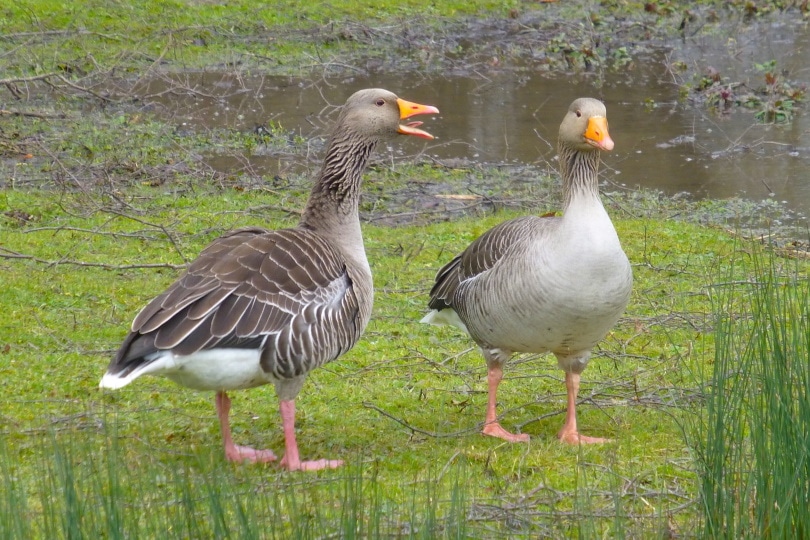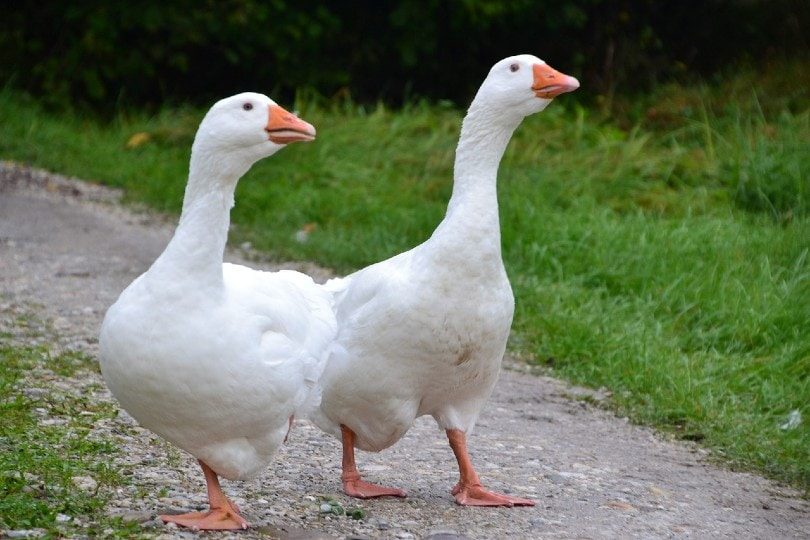Why Are Geese So Aggressive? Geese Behavior Explained!
Last Updated on

The ancestors of European and Asiatic geese roamed the earth over 10 million years ago, but the birds’ long history did not tame their protective or aggressive behavior. Ducks and chickens can learn to socialize and even grow fond of humans, but geese are wary of any human interference. They’re territorial birds that regard any approaching human as a threat to their mates and offspring. A goose is unlikely to attack you unprovoked, but if you step inside the imaginary line the bird considers its territory, you’re likely to get an unfriendly warning followed by a spirited attack.

The Reasons for the Bird’s Behavior
Geese are generally protective of their space at all times of the year, but they’re more aggressive towards humans when they’re mating or nesting. Unfortunately, geese only nest on the ground, and they often dig a shallow hole and line it with leaves and twigs. Geese feel safer from predators when nesting on the ground, and most will build a home close to the bank of a pond or lake. Because the nest is usually hidden by dense vegetation, they’re easy to stumble upon if you’re hiking near a natural water source. Male and female geese are overly protective of their babies, but the gander (male) is more likely to attack an intruder while his mate protects the eggs.
Raising and protecting their young are the two most important functions of goose parents, and they want their nesting period to be calm and free of interruptions. They prefer to avoid conflicts with humans and other animals, but they’re never hesitant to express their rage when something approaches their home.
Geese are not highly intelligent, but they’re aware that their towering body and stubby legs are not designed for speed or quick escapes. Whether it’s a large predator like a crocodile or wolf or an innocent human out for a walk, a goose will defend its flock rather than attempt an escape. With a long neck, thick body, and bright yellow bill, geese are tempting targets for nearby predators. Fleeing a fight is not an option for a goose, but it will give its unwelcome guests plenty of warning before it stages an attack.

Warning Signs That Precede an Attack
Before you’re bitten or knocked unconscious with the tip of a wing bone, a goose gives you plenty of time to walk away with your dignity.
Vocal Warning
Initially, the bird will make a loud squawk and warn you to back away. If its fear escalates, it will bend its head down and continue shrieking. If you refuse to move, the goose will straighten out its neck and begin bobbing its head. At that point, an attack is coming, and it may be your last chance to leave without a scratch.
Posture
Next, the fierce bird will raise its wings to appear larger and leap at you to attack. Geese have a slightly pointed bill but do not have sharp teeth that can cause severe wounds. However, their large, heavy wings can also be used to attack. Although a sudden violent maneuver from an intimidating bird can be horrifying, you should not respond by kicking, punching, or throwing rocks at the bird. Retaliating with force will only enrage the goose and escalate the attack. They may seem scary, but they’re more fragile than they look and can incur broken wings, eye damage, or neck injuries from a powerful kick or punch. Preventing injuries to you or the bird only involves following a few simple steps.

How To React To a Goose Attack
If an attack is imminent and the bird is preparing to lunge at you, slowly back away while keeping your gaze on the bird. Avoid yelling or making sudden movements because the bird will think you’re provoking it. Keep backing away until it has stopped moving and screaming. Staying calm while you’re backing away will signal to the goose that you’re not fearful or willing to use violence to harm its family. When you’re far enough away, the bird will calm down and move back to the flock.

How To Avoid Aggression From a Goose
A goose attack is not something that any human wants to experience, and you’re less likely to witness aggression from a goose if you keep your distance. In a suburban setting or wild environment, geese prefer to be around their species. In the wild, they go to great lengths to hide from predators. They set up nests on deserted islands far away from threatening species or humans to keep their offspring safe.

Avoid Feeding Them
A goose does not want you to approach its nest, but it certainly will not refuse food if you offer. Feeding the geese in the park may seem like a relaxing, beneficial task, but it makes the birds more emboldened towards other humans. If you feed the geese every day at the same time and then pause for a few days, the visitors during your absence are more likely to encounter aggressive birds. When a group of humans without food approach the same flock, the geese may express their frustration with loud screaming and possibly an attack.
Stay Away From Nests
When walking near waterways, try to keep your distance when you see a flock of geese in the water. Wild geese will sleep while floating on the water, and you have to be careful not to wake them up when you walk near the water’s edge at night. Nests are not easy to spot from a distance, but they’re usually not too far from where the birds gather.

Conclusion
Geese are gorgeous birds that seem graceful and calm when they’re floating in a pond or lake, but when they perceive a threat to their family, they quickly leap into action. Although most goose attacks do not result in serious injuries, you can avoid upsetting a fierce bird by staying away from the nest and flock. Geese are aggressive to humans when they get too close, but the birds provide plenty of warnings before they decide to launch an attack.
Featured Image Credit: Piqsels
About the Author Robert Sparks
Robert’s obsession with all things optical started early in life, when his optician father would bring home prototypes for Robert to play with. Nowadays, Robert is dedicated to helping others find the right optics for their needs. His hobbies include astronomy, astrophysics, and model building. Originally from Newark, NJ, he resides in Santa Fe, New Mexico, where the nighttime skies are filled with glittering stars.
Related Articles:
How to Clean a Refractor Telescope: Step-by-Step Guide
How to Clean a Telescope Eyepiece: Step-by-Step Guide
How to Clean a Rifle Scope: 8 Expert Tips
Monocular vs Telescope: Differences Explained (With Pictures)
What Is a Monocular Used For? 8 Common Functions
How to Clean a Telescope Mirror: 8 Expert Tips
Brightfield vs Phase Contrast Microscopy: The Differences Explained
SkyCamHD Drone Review: Pros, Cons, FAQ, & Verdict
